Video Assistant Referee causes controversy every week in the Premier League, but how are decisions made, and are they correct?
After each weekend we take a look at the major incidents to examine and explain the process both in terms of VAR protocol and the laws of the game.
– VAR in the Premier League: Ultimate guide
In this week’s VAR Review: Should Liverpool have been awarded a penalty for handball by Chelsea‘s Nicolas Jackson? Why offsides should be getting a bit quicker, as seen in Newcastle United vs. Aston Villa. Plus all the rest of the drama from the opening weekend of the season.
Possible penalty: Handball by Jackson
What happened: Liverpool had a corner in the 53rd minute, with Luis Díaz flicking Dominik Szoboszlai‘s delivery on at the near post. The ball hit Nicolas Jackson and went behind for another corner, but it came off a raised arm. Should it have been a penalty?
VAR decision: No penalty.
VAR review: In the Premier League, there has always been a more lenient interpretation of handball. As Jackson was jumping, he had his arm close to his body, and Díaz’s flick meant there was little time to react to the movement. Both of Jackson’s arms were in the same position, which suggest expected position for his movement in that situation.
If referee Anthony Taylor had awarded the penalty, then it would surely have stood. But the VAR, Darren England, had enough questions to ask himself not to intervene.
Had Jackson had his arm further away from his body, or if he had moved it toward the ball, we would have seen an intervention. On Friday at the Women’s World Cup, Japan defender Fuka Nagano was penalised with her arm in a similar position — the difference being her hand appeared to move to the ball.
At the end of the match at Stamford Bridge, there was another handball claim, but Szoboszlai came from off the pitch to receive a touch from Harvey Elliott. A player off the field was judged to be on the nearest point of the pitch, so Szoboszlai was immediately offside when he became involved in the play before the possible handball.
Possible red card: Chukwuemeka challenge on Konaté
What happened: Carney Chukwuemeka was booked in the fourth minute when he caught Ibrahima Konaté with a high challenge, but was it worthy of a red?
VAR decision: No red card.
VAR review: Chukwuemeka’s challenge was a yellow card, as there was no force in the way he made contact with the Liverpool player.
We saw several similar situations last season, such as Diogo Jota‘s high boot on Tottenham Hotspur midfielder Oliver Skipp, where the Independent Key Match Incidents Panel agreed a yellow card wasn’t the incorrect outcome.
Possible offside: Botman and Burn on Isak goal — and how offsides will get quicker
What happened: Newcastle United went 2-1 up in the 16th minute, when Alexander Isak scored from Sven Botman‘s centre following a free-kick routine. However, there were two possible offside situations for the VAR, Simon Hooper, to consider.
VAR decision: Goal stands.
VAR review: Let’s start with a possible offside against Dan Burn before looking at a change in how the tech will be used in the Premier League this season. (Isak’s offside position isn’t relevant, as he is not involved in the first phase.)
Burn, who was in an offside position as Sandro Tonali delivered the ball into the box, was in direct contact with Matty Cash. For this to be an offence, Burn doesn’t need to be fouling Cash, only preventing him from being able to challenge for the ball. Botman had lost his marker, John McGinn, so the question is whether Cash would have had a realistic chance of making a block or interception without the actions of Burn.
Villa fans will remember this aspect of offside well, as they had a goal disallowed at Manchester United in the FA Cup when an offside Jacob Ramsey blocked the run of Edinson Cavani and the goal was ruled out through a VAR intervention. In that case, Cavani would have been challenging toward the Villa player, rather than round the back of him, so would be judged as having a greater chance of going for the ball. It’s subjective, for sure, but there’s enough doubt that Cash would have been able to get to Botman.
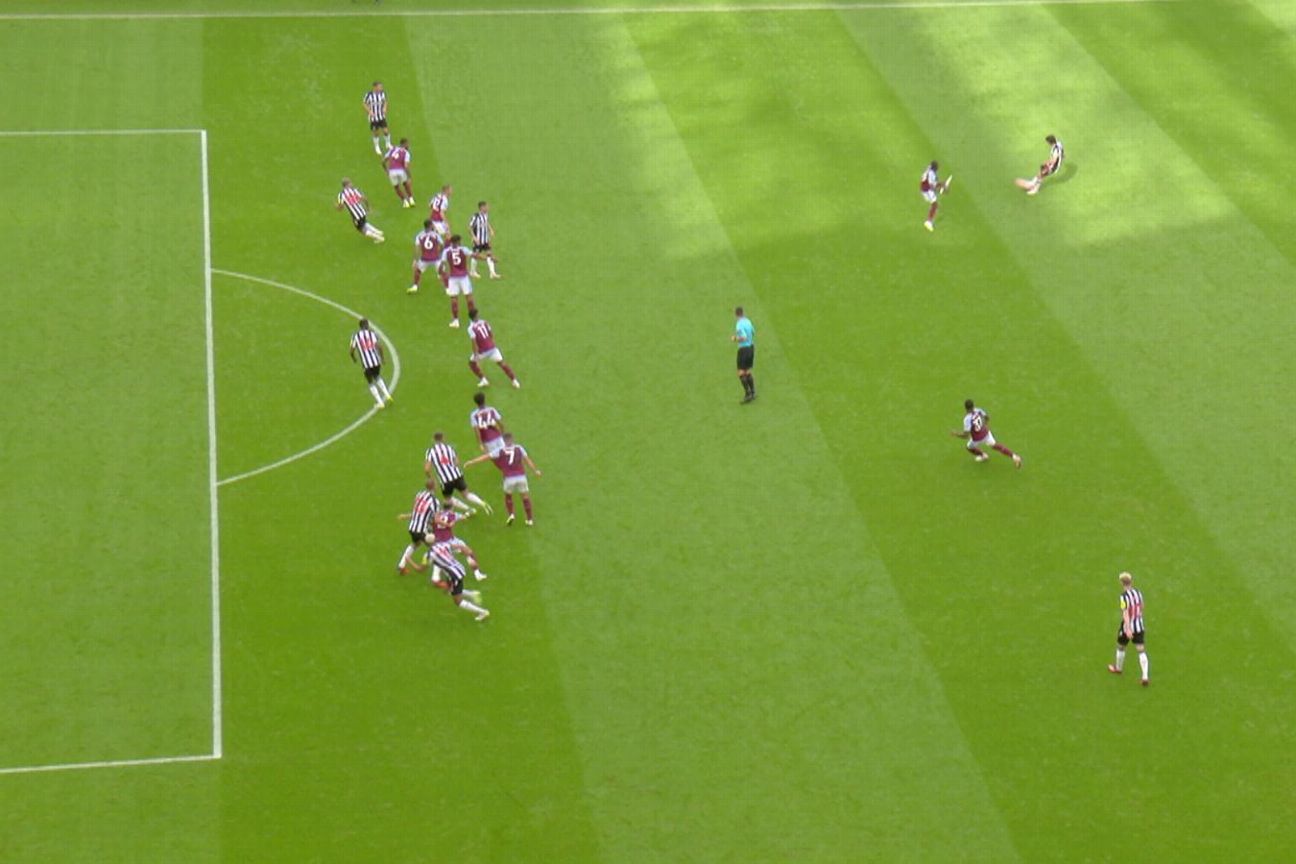
Fans questioned the lack of offside graphics shown during this game, and it’s all about the Premier League trying to quicken things up when it’s clear that the on-field decision is correct.
Additional cameras have been placed around both penalty areas to make offside decisions more reliable with the current technology, and these angles can help speed it up.
The VAR will still go through the regular process of assessing the offside situation and placing the calibrated lines to the pitch and to the players. If there is no possibility the decision will change, the check will be completed and play will restart — be that with a free kick to the defending team or a kickoff.
So, when the lines were placed to Botman and Cash, it was immediately clear to the VAR that the Newcastle player who created the goal would not be offside.
The positive is it should reduce a lot of the time spent waiting for a decision, however, some fans may believe that the final graphic is needed as proof. It’s a tradeoff between being quicker and always having the evidence.
The same situation applies to the fourth Newcastle goal, when Harvey Barnes was onside before creating a goal for Callum Wilson. Once the VAR started to apply the tech, he knew the right foot of Pau Torres was playing Barnes onside, so there was no need to spend any additional time creating the image.
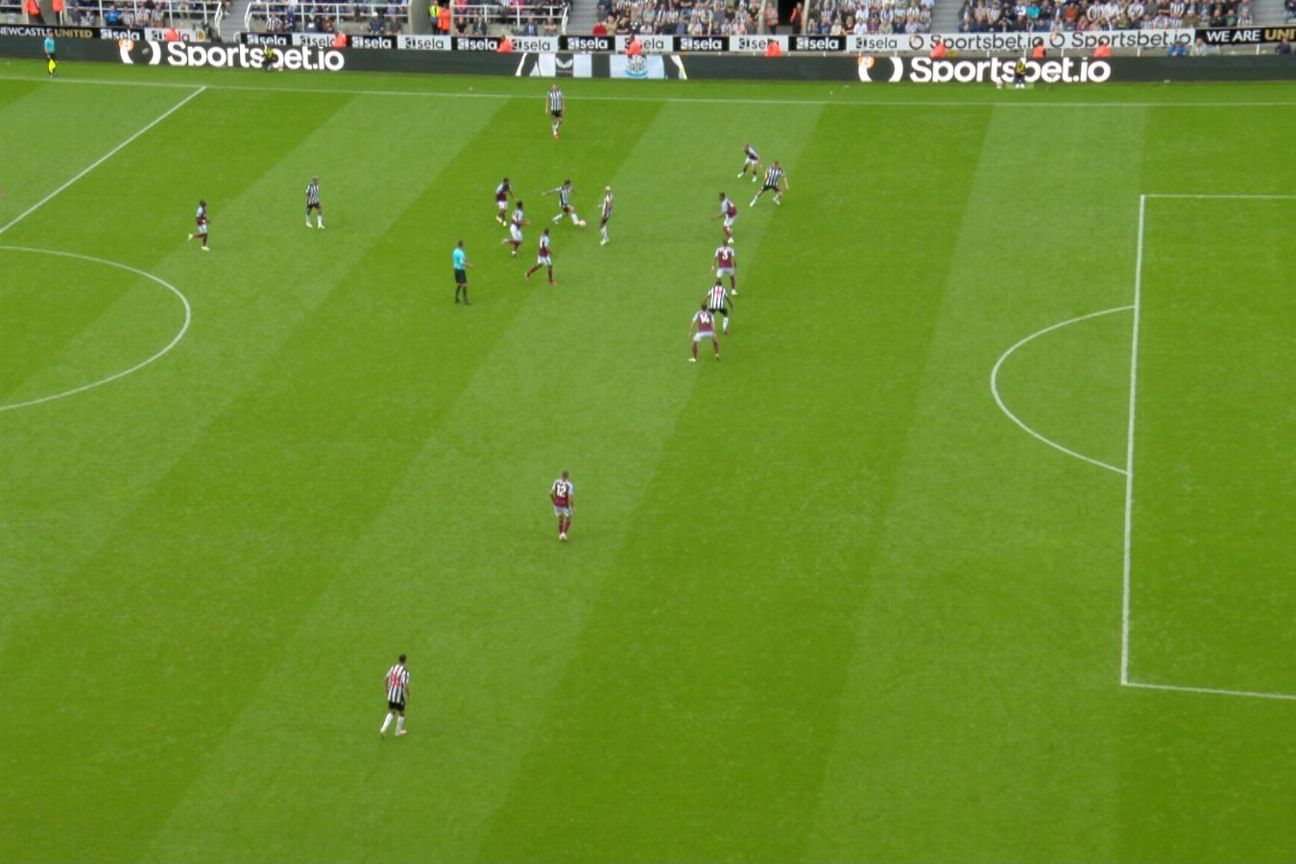
Both these goals were cleared very quickly, but in the Brentford vs. Tottenham game, it took an extended time for the goal to be confirmed, as the VAR had to go through the full process and create the graphic. It was so close that Cristian Romero was only onside by the tolerance level afforded to attackers when the two offside lines are touching.
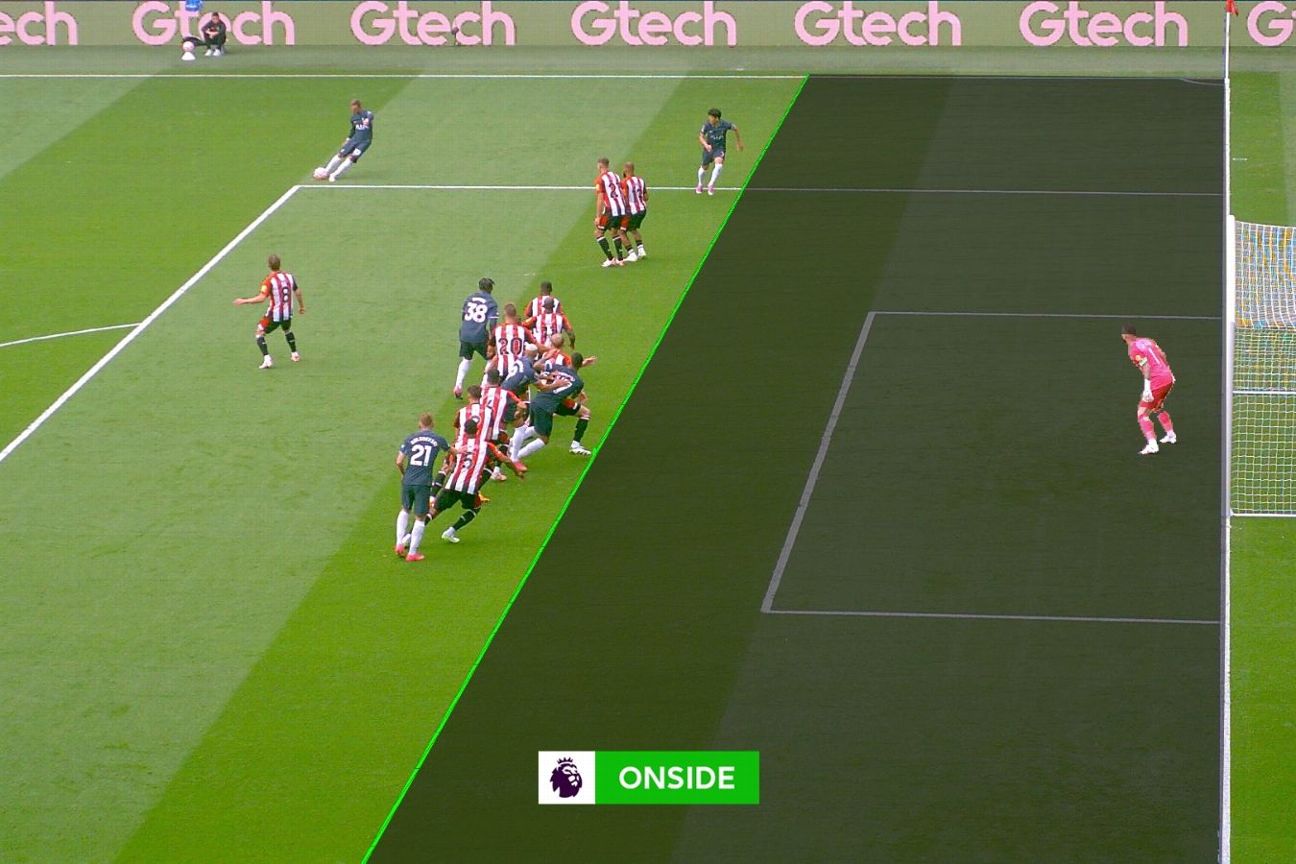
The offside graphics were needed for a different reason in Chelsea vs. Liverpool because twice an on-field decision was overturned. Even though both Mohamed Salah (watch here) and Ben Chilwell (watch here) were, in VAR terms, offside by a large amount, the graphic was needed to prove the assistants’ decisions were incorrect.
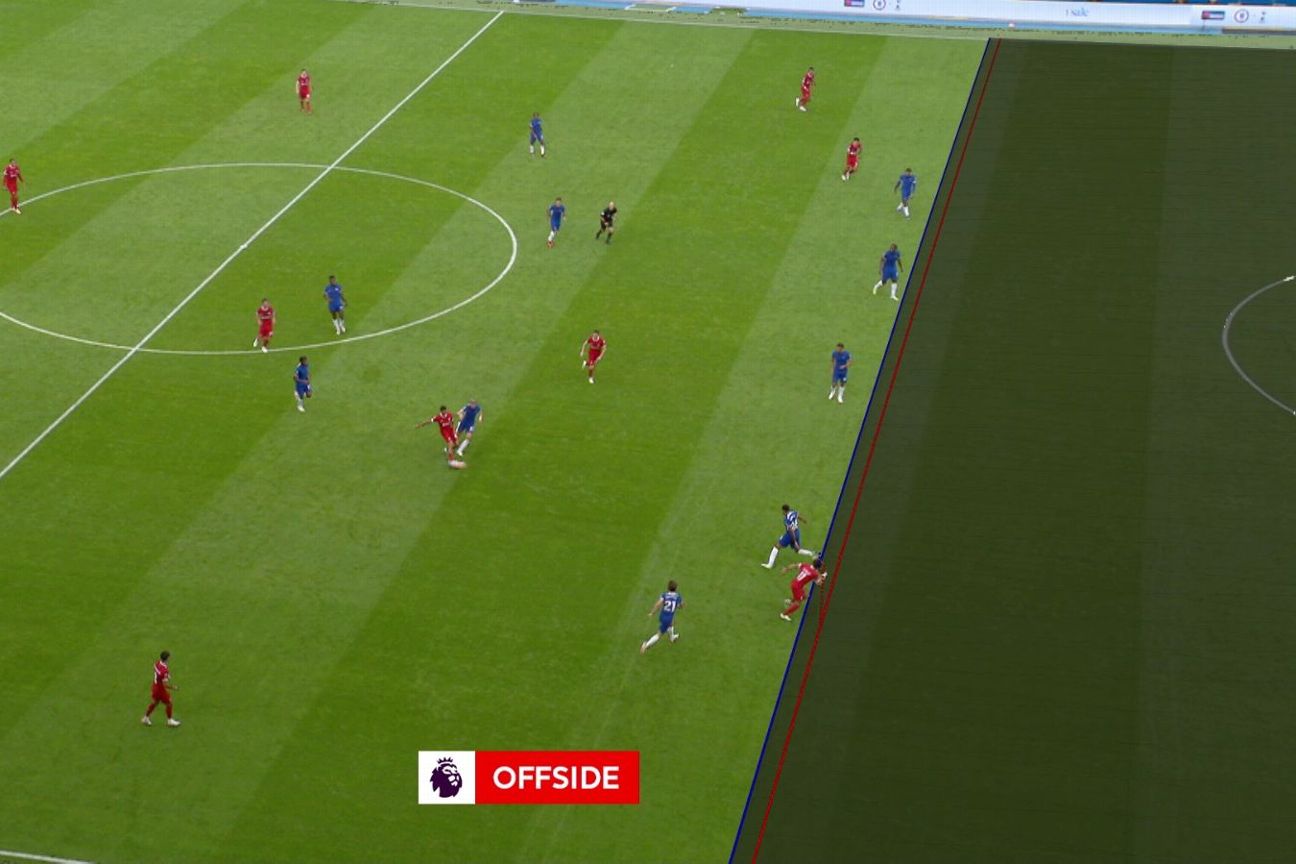
The decisions each took more than 1½ minutes, while if the flag had gone up at the end of the move, both would likely have needed a quick application of the tech to confirm.
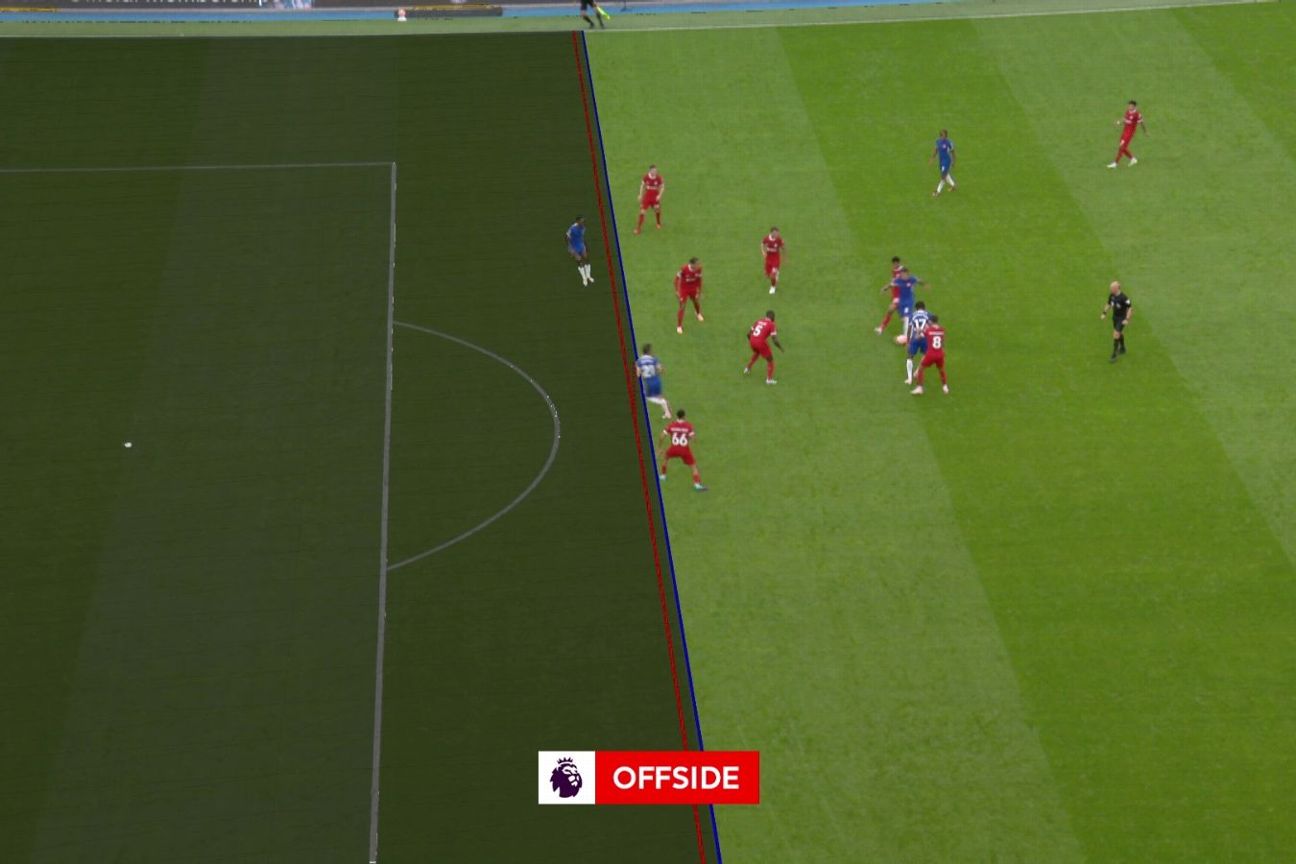
Possible red card: Martinez for challenge on Almirón
What happened: Nine minutes into added time at the end of the first half Miguel Almirón broke down the right flank but was taken out by goalkeeper Emiliano Martínez, who had rushed from his area. Referee Andy Madley booked Martínez, but was there a case for a red card? (watch here)
VAR decision: No red card.
VAR review: For Martínez to be sent off, he would need to deny a clear goal-scoring opportunity, and the goalkeeper being out of his area when he makes the foul, even if it’s cynical, doesn’t automatically make that the case.
Almirón’s direction of travel is toward the corner flag, and not to goal, while there are a number of covering defenders, so a yellow card would be the correct decision.
Possible penalty: Handball by Rice
What happened: Nottingham Forest won a corner in the 77th minute. It was taken by Morgan Gibbs-White, and as Declan Rice jumped with Willy Boly, the ball hit the arm of the Arsenal player. There were no real appeals, though Forest boss Steve Cooper questioned after the game why a penalty wasn’t awarded.
VAR decision: No penalty.
VAR review: One of the keys to this decision is the position of Rice’s arms as the corner comes into the box. Rice has his arms on Boly as they both jump for the ball, and it’s as he removes his hand from his opponent that the ball strikes it. The arm isn’t away from the body in a way that is creating a barrier, nor it is above shoulder height or in an unexpected position for a player jumping for the ball with another player.
There are some similarities with the handball penalty Forest didn’t get against Manchester United last season, when the ball hit the arm of Harry Maguire. In that case too, Maguire was battling and his arm didn’t move from the position it was in as the ball came across. The Independent Key Match Incidents Panel ruled it was correct not to award a penalty in that case, and it will do the same with Rice.
Possible penalty: Foul on Havertz in the buildup to Awoniyi goal
What happened: Forest pulled a goal back in the 82nd minute when they broke from a corner and Taiwo Awoniyi scored, but there was a question of a possible foul by Joe Worrall against Kai Havertz in the Forest area right at the start of the move.
VAR decision: No penalty.
VAR review: It wouldn’t be the first time in the Premier League that a goal was disallowed to award a penalty to the opposing team, but while there is a case for a foul by the Forest defender, it’s really just two players jumping for the ball and the Arsenal player getting up first. If Worrall had caught Havertz with his arm, thus making it less of a genuine challenge, there would have been a stronger case for a VAR intervention.
Possible penalty: Foul by Son on Jensen
What happened: Brentford pushed forward in the 27th minute, and when Mathias Jensen attempted to check back inside the box, he went down under a challenge from Son Heung-Min. Referee Robert Jones allowed play to continue, but the VAR, Tony Harrington, initiated a review for a penalty.
VAR decision: Penalty, scored by Bryan Mbeumo.
VAR review: We’re told that contact must have a consequence if the VAR is to get involved in a penalty situation, and this has to be on the border.
Does Son catch Jensen? Definitely. Does it make Jensen go down in the manner that he did? Debatable. Did Jensen hold the wrong ankle when he went to ground asking for the spot kick? Yes.
Level of contact will always be open to interpretation, and we shouldn’t be surprised if similar situations don’t result in a VAR penalty, and Spurs can consider themselves unlucky.
Possible penalty: Foul by Vicario on Schade
What happened: In the 87th minute, Kevin Schade was sent through on goal and fired wide — but was caught by goalkeeper Guglielmo Vicario, who had come out to close down the angle. The goal kick was awarded, but was there a case for a penalty?
VAR decision: No penalty.
VAR review: It’s a question that’s asked regularly: Why can a defender or goalkeeper take out an attacking player after they have released the shot? It’s effectively an unwritten law that if a player completes the action of the shot, then there will be no foul unless it crosses the line to be reckless or dangerous.
In this case, Vicario was coming forward to make a genuine attempt to play the ball and it’s judged that the players came together as natural football contact; there’s nothing the player could have done to avoid the coming together.
Last season Éderson was adjudged to have fouled Arsenal forward Eddie Nketiah when coming out from goal, the difference being the Manchester City goalkeeper had no realistic chance of playing the ball in the way he challenged and was more likely to get the opponent than the ball. They are small but crucial interpretations — is the collision inevitable or has the goalkeeper made sure the contact takes place?
Possible goal: No foul on Leno for Keane goal
What happened: It was 0-0 and Everton thought they had the lead in the 35th minute when Michael Keane put the ball into the net after Bernd Leno had fumbled, but referee Stuart Attwell had blown his whistle for a foul on the goalkeeper by James Tarkowski.
VAR decision: No VAR intervention possible.
VAR review: The referee blew his whistle before the ball crossed the line, so play was dead from that moment and anything that follows is invalid. It means there is no possible goal for the VAR to review, so Thomas Bramall can only advise that play restarts with the free kick to Fulham.
It was a very soft decision, with Tarkowski making no obvious action to back into the goalkeeper and cause a foul. If the goal had been allowed on the field, it’s very unlikely the VAR would have advised it should be ruled out.
However, this is all moot because Keane was in a offside position when the ball came off Tarkowski. So even if the referee had held the whistle and the VAR decided no foul, it would have been chalked off for offside.
Premier League referees are now usually very good at holding the whistle until the ball crosses the line on possible foul situations. It should have happened here, even if the outcome of a free kick to Fulham would still be the same.
Possible penalty overturn: Lockyer foul on Pedro
What happened: Brighton were awarded a penalty in the 71st minute when João Pedro went down inside the area under a challenge from Tom Lockyer. Referee David Coote pointed to the spot.
VAR decision: Penalty stands, scored by Pedro.
VAR review: While the VAR, Robert Jones, checked the award of the spot kick, there wasn’t enough for it to be considered an error. While it was certainly on the softer side, Lockyer has his arm across the Brighton attacker, and if this is the offence that the referee has identified, then there would be no real grounds for a VAR review. As ever, the decision on the field carries the most weight.
Possible penalty overturn: Handball by Dunk
What happened: Luton Town were awarded a penalty of their own in the 81st minute when Jacob Brown‘s cross was blocked by Lewis Dunk, with referee Coote pointing to the penalty spot.
VAR decision: Penalty stands, scored by Carlton Morris.
VAR review: This is a perfect example of a situation where the letter of the law and VAR protocol collide to create a situation where no penalty would be the better outcome, but the penalty must stand as awarded.
Dunk slides in to block the cross and has his arms raised above his body, putting himself at serious risk of conceding a penalty kick. That the ball hits him on the elbow that is hidden from the ball makes him very unlucky. While he has made himself bigger, the ball hitting the leading arm would be the clearer offence.
The elbow isn’t a long way from his body, but it is far enough for the VAR to be locked out of intervening once the referee has given the spot kick. If Coote hadn’t pointed to the spot, there’s every chance that VAR Jones would have supported that call.
There was an incident in the 88th minute of Everton vs. Fulham that provided a comparison. James Tarkowski blocked a shot from Aleksandar Mitrovic from very close range, and while the ball came off the defender’s elbow he was attempting to tuck his arm into his body. This one wasn’t given by the VAR, and we could expect the same to happened to Dunk had the whistle not gone.
Two incidents that provide the perfect example of similar situations with different outcomes due to the decision on the field of play; and that’s simply how VAR protocol operates.
Possible penalty: Akanji foul on Amdouni
What happened: In the seventh minute, Zeki Amdouni went to ground in the box against a challenge from Manuel Akanji; he appealed for a penalty, but referee Craig Pawson waved away the appeals.
VAR decision: No penalty.
VAR review: While there was upper body contact from Akanji on Amdouni, it certainly wasn’t sufficient to make the Burnley player go to ground in the way he did. No chance that the VAR would intervene in this situation.
Possible handball: Ake before Rodri goal
What happened: Man City scored their third goal in the 75th minute when Rodri lashed home from close range, but the ball appeared to strike the arm of Nathan Aké immediately before.
VAR decision: Goal stands.
VAR review: Accidental attacking handball is only an offence if it’s by the goal scorer, so the ball coming off the hand of Ake could only be an offence if it was a deliberate act.
Possible red card: Zaroury for tackle on Walker
What happened: In the fourth minute of added time, Kyle Walker had escaped the Burnley defence and broke clear down the right. Anass Zaroury gave chase and brought down the England international. Referee Pawson gave himself a bit of thinking time before producing the yellow card.
VAR decision: Yellow card upgraded to red.
VAR review: The nature of the challenge from Zaroury made this an easy review for the VAR, Michael Oliver. Had Zaroury simply tripped Walker, then a yellow card for stopping a promising attack would have been sufficient. However, Zaroury led with his studs and caught the City player high above the ankle on the calf.
It was a clear case of serious foul play, and once Pawson had seen the contact at the monitor, there was only going to be one outcome.
Information provided by the Premier League and PGMOL was used in this story.
